MTA Bosses Say Albany Can Pay to Keep Full Service Five Days Per Week


Money can buy happiness and it can buy first-ballot Hall of Fame infielders — and it can also buy transit service.
MTA bigwigs said on Wednesday that if Albany funded the transit agency appropriately, they could undo some planned service cuts.
“All good things can happen if people are willing to pay for them, or help figure out recurring funding sources, which is what MTA needs to achieve fiscal stability,” MTA Chairman and CEO Janno Lieber said when asked if a state cash infusion could forestall schedule changes that the agency announced on Monday.
Earlier this week, the MTA said that it was going to tweak service on a number of lines next June due to altered commuting patterns. On the one hand, the agency said it would increase weekend service on the G, J and M lines in response to weekend subway ridership consistently hitting 70 percent or greater of pre-pandemic ridership.
But the agency also said it would trim peak hour service on the 1, 6, 7, L, E, F and Q trains on Mondays and Fridays, which were days that have seen consistently lower ridership compared to Tuesdays through Thursdays.
“In this instance, we’re very modestly aligning the service that our customers are asking for today,” said New York City Transit President Richard Davey. “At the moment our customers are saying, ‘Hey, we want more weekend service, we want more bus service,’ and we’re delivering on that. And then on Mondays and Fridays, a couple of hours each of those days there are instances where folks are not using the services as much and the average [additional] wait time will be between three and 30 seconds. But could we run more weekend service? I think we would love to if we could find a way to pay for it.”
Despite the short additional wait times on two weekdays, the move still drew brickbats from advocates and transit workers.
“Ridership is between 70 percent and 80 percent of pre-pandemic levels at more than 50 stations in the Bronx, Queens, and Brooklyn,” said Richard Davis, president of TWU Local 100. “These include stations on the 6 line in the Bronx, and the 7 line in Queens — lines that are facing service cuts. I have no doubt that service cuts will increase rider frustration. That will lead to more assaults on transit workers — and we are fed up beyond belief with assaults.”
And it may not only be 30 seconds; union sources said MTA leadership shared a scheduling document that showed an extra minute of wait time between 8 a.m. and 9 a.m. on Fridays on the L train. The time between trains would rise from three minutes to four.
The service cuts took a step closer to becoming a reality on Wednesday when the MTA Board approved a 2023 budget that would allow it to raise fares next year. The budget did not lock in the fare hikes or service tweaks, but hearings on the fare hikes, which could be as high as 5.5 percent, will begin in February if there are now additional state funds to avoid them.
Albany is about to kick off a budget season in which it will be reckoning with the future of the MTA’s financial life and how to fill the agency’s $2-billion fiscal hole, a future that the bigwigs of Gov. Hochul and Mayor Adams’s New New York panel said should not be so beholden to farebox revenues.
How the state fills in that future is still unknown. Hochul has said that she won’t reveal her budget until she reveals it, but she is also the latest governor to be implicated in financial chicanery that has underfunded the MTA by over $180 million per year recently. On the legislative side, State Sen. Mike Gianaris and Assembly Member Zohran Mamdani, both of Queens, have introduced a package of bills that they say would freeze fares, fill the MTA’s fiscal hole, pay for additional off-peak subway service and additional bus service and make buses free.
The shakiness of next year’s MTA budget and the possible service cuts were as a good a reason as any to pass the bills, said one of the package sponsors.
“In order to ensure New Yorkers have a transit system that works for them, we have to fill the MTA’s financial shortfall and ensure against service cuts and or fare hikes,” said Mamdani. “We have to fix the rot at the heart of the transit system, which means we have to pass the package of bills known as the ‘Fix the MTA.'”